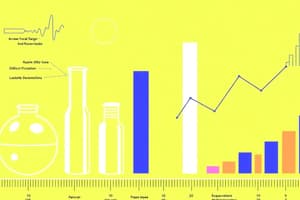Podcast
Questions and Answers
In research design, what is the primary purpose of employing an experimental approach?
In research design, what is the primary purpose of employing an experimental approach?
- To describe the characteristics of a population or phenomenon.
- To enable the researcher to test hypotheses by establishing valid conclusions between variables. (correct)
- To investigate an individual, group, or event using theories.
- To explore and understand people's perceptions of a particular situation.
A researcher aims to understand the lived experiences of nurses during a pandemic. Which research design is most suitable?
A researcher aims to understand the lived experiences of nurses during a pandemic. Which research design is most suitable?
- Phenomenology (correct)
- Experimental
- Survey
- Descriptive
Which of the following best describes the purpose of descriptive research design?
Which of the following best describes the purpose of descriptive research design?
- Describing the characteristics of a population (correct)
- Testing a hypothesis between variables
- Understanding cause-and-effect relationships
- Exploring the meaning of lived experiences
In the context of research methodology, what is 'data saturation' primarily associated with?
In the context of research methodology, what is 'data saturation' primarily associated with?
What is the primary distinction between probability and non-probability sampling?
What is the primary distinction between probability and non-probability sampling?
A researcher uses existing government reports to analyze the impact of a tourism policy. What type of research design is the researcher employing?
A researcher uses existing government reports to analyze the impact of a tourism policy. What type of research design is the researcher employing?
During the data gathering procedure, what is the purpose of obtaining administrative clearance?
During the data gathering procedure, what is the purpose of obtaining administrative clearance?
What should a researcher do to ensure ethical considerations are met during a study?
What should a researcher do to ensure ethical considerations are met during a study?
In research, why is it important to describe the validation process of a research instrument?
In research, why is it important to describe the validation process of a research instrument?
When designing a survey, what is the significance of pilot testing the instrument?
When designing a survey, what is the significance of pilot testing the instrument?
Flashcards
Experimental Research Design
Experimental Research Design
A blueprint to test hypotheses by reaching valid conclusions between independent and dependent variables.
Outcomes Based Design
Outcomes Based Design
Seeks to understand the end results of a particular subject or program.
Critical Research
Critical Research
Uses critical thought to reveal faulty sociological claims.
Survey Research
Survey Research
Signup and view all the flashcards
Descriptive Research Design
Descriptive Research Design
Signup and view all the flashcards
Phenomenology
Phenomenology
Signup and view all the flashcards
Case Study
Case Study
Signup and view all the flashcards
Probability Sampling
Probability Sampling
Signup and view all the flashcards
Non-Probability Samples
Non-Probability Samples
Signup and view all the flashcards
Study Notes
Research Design
- Identification of the research approach is required which can be Quantitative, Qualitative, or Mixed.
- An approach must be defined with citations.
- Application and reasons why the approach was the best for the study, with citations are needed.
- Qualitative research is primarily exploratory through focus groups, individual interviews, participation, and observation.
- Quantitative research uses numerical data from online, paper, mobile, and kiosk surveys, and online polls.
Research Design Types
- Research design can be experimental, descriptive, phenomenological, case study, or convergent; definitions and applications with citations are needed.
- Experimental design is a procedure blueprint to test hypotheses and reach conclusions between variables.
- Descriptive design describes population or phenomenon characteristics.
- Phenomenology studies perception and understanding of a situation.
- A case study investigates an individual, group, or event, using theories and involving the researcher.
- A convergent design involves mixed methods.
Supplementary Research Design
- Supplementary designs include outcomes-based, documentary analysis, critical, or survey research.
- Definition and application with justification are required.
- Outcomes-based research seeks to understand the end results of a subject.
- Documentary analysis uses documents.
- Critical research reveals faulty sociological claims using critical thought.
- Survey research selects a respondent sample to administer a standard questionnaire.
Research Locale
- Identification of research location is needed, including geographical location and justification for its selection.
- Citing sources is recommended.
Research Instrument
- Discussion of the instrument is used to gather data.
- Whether the instrument to be used is researcher-constructed, copyrighted, or adapted must be indicated.
- Clarification of response modes and scales should be included in the evaluation tool.
Instrument Details
- Researcher made or standardized questionnaires, should be identified
- The numbers of parts, pages and type of questions and amount of questions asked should be identified.
- Verbal interpretation and time constraints should be considered
- Validation process, content validity and face validity should be considered.
Non-Quantitative Instrument Details
- For non-quantitative surveys and interviews an interview schedule should be done.
- Separate interview schedules are needed for triangulated studies and multiple participants.
- Observation includes writing notes and storage of data.
Population
- The population refers to the individuals with characteristics of interest, with sampling as a chosen proportion.
- Identification of the unit of analysis and participants is needed, including criteria.
Sampling
- The sample sizes and computations need to be presented
- Identification and justification of a sampling technique with citations is needed.
Sampling Methods
- Probability sampling methods allow knowing the likelihood of element selection.
- Probability sampling includes simple random, systematic random, cluster, and stratified random sampling.
- Non-probability samples does account for the odds of element being selected
- Non-probability samples include availability, quota, purposive, and snowball sampling.
Data Saturation
- Data saturation is a qualitative research term that is often used in grounded theory approach.
Data Gathering
- Process that contains the procedure followed by the researcher from the time of the distribution of the instrument/questionnaire up to the time of retrieval.
- The procedure should be represented in a flowchart or Gantt chart.
Data Collection
- Administrative clearance is gained via a letter and endorsement.
- The letter should be noted by any advisors
- Ethical considerations for minimizing risk, ensuring informed consent, and minimizing conflict of interest should be documented.
Data Collection Procedure
- A process is needed to explain how the respondents where accessed and how the questionnaire was administered
- All other procedures are taken into consideration
- Observation, online data, photos films and other social artifacts and product/outcome/plan need to be considered
Validation of the Instrument
- There needs to be an inclusion of the procedure on how the instrument was validated for content and construct
- Validation certificate is required
Statistical Data
- Identifying statistical tools used in treating data is required
- Formulas are not needed unless uncommon .
- Indicate the title of any statistical package used.
Ethical Considerations
- The document covers minimizing risks, conflict of interest, and exploitation.
- Informed consent is needed.
- Ethics Review Board of St. Paul University Manila has to be followed.
Studying That Suits You
Use AI to generate personalized quizzes and flashcards to suit your learning preferences.




